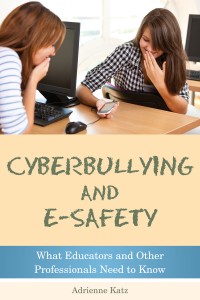 To mark Anti Bullying Week 2013 (18th – 22nd November), JKP author Adrienne Katz discusses how online bullying can be prevented with more effective e-safety education. Rather than running one-off e-safety sessions which can be easily missed or the information forgotten, she argues the case for continuous e-safety support in schools and discusses how particularly vulnerable teens can be better served by this system.
To mark Anti Bullying Week 2013 (18th – 22nd November), JKP author Adrienne Katz discusses how online bullying can be prevented with more effective e-safety education. Rather than running one-off e-safety sessions which can be easily missed or the information forgotten, she argues the case for continuous e-safety support in schools and discusses how particularly vulnerable teens can be better served by this system.
Thank goodness for ten year olds! They are the most likely age group to actually listen to e-safety advice and follow it. But sadly, this is short-lived.
Most young people say they have been taught about staying safe on the internet. They even say this education was good or quite good. But before educators pat themselves on the back, there is some sobering news. Rather like adults who see health messages about cigarettes and then go outside their workplace to smoke, teenagers tend to ignore what they have learned. The most vulnerable teenagers are the most likely to say ‘it goes right out of my head when I’m talking to friends online.’
It is these vulnerable teenagers who need something different. The standard universal e-safety education offered does not really address their needs. Young people in care, those who are young carers and those with special needs may require a more targeted approach with extra support. They might not have been in school when a one off session was delivered, perhaps by an outside agency and in any case, once that session is over that person leaves the school and pupils cannot ask a question or turn to them for help.
Children who are bullied in school will often go online to retaliate – in this realm they may be powerful, take risks and try to get their own back. Alternatively they often seek friendship online because they are shunned in school. Young carers may be home a lot more than their friends and they may have a lively online life. People who are known to be depressed or especially those who self-harm, are anorexic or troubled – perhaps through bereavement or loss – may visit websites that promote eating disorders or even suicide. They may gratefully make friends with someone who is intent on harm.
Then we have the current youth trend of self-generated photos that somehow escape the confines of an intimate relationship – it is estimated by the IWF that 88% of these images turn up on parasite websites. So often a photo is lovingly shared during a relationship and pressure is increased to send something a little raunchier or more revealing. Gradually a number of these images are shared leaving the sender open to blackmail, extortion and threats when things go wrong. Sometimes the sender thinks they are in a relationship with another teenager when in reality it is actually an adult predator posing as a young person. 22% of teens said they had been blackmailed or threatened by someone over a private image on a webcam or shared in a relationship.
Learning this from a large sample of 17,500 young people aged 10 -16+ has led to workshops to explore how we might deliver e-safety in new ways that resonate with our young people. They devise new content, help teach one another and generally act as valuable partners in our exploration of the new digital world we inhabit. E-safety should not be something that adults deliver to children – rather it should be a journey of exploration on which we embark together, sharing what we find out and supporting each other.
While we want to encourage young people to report problems and worries they have online, we as adults will have to improve our responses when they do report it. Only 43% of those who reported being cyberbullied said they got help to get it to stop. 55% of those said it did stop as a result. But what about the cases where it got worse or stayed the same?
Tragic cases such as the recent deaths of Hannah Smith, Daniel Perry and Issy Dix show that young people are flocking to sites such as Ask.fm – in part to have a private space now that parents have understood that they should be ‘friends’ on Facebook to follow their child’s online life. Here bullying is aided by the anonymous message feature. But do they know they can switch this off? The resilient, stronger ones are able to walk away if trolls are active. For some though, the magnetic pull of returning again and again to see what people are saying about them, proves too strong. They need our help.
Below are some interesting findings from the survey of 17,500 young people aged 10-16 about e-safety:
- Young people were asked: If you were taught about e-safety do you follow this advice?
– In 2009 only 26% of 14-15 year olds said they always followed it. In 2013 this figure is 31%.
– 46% of girls and 35% of boys say they always follow the advice.
- Boys are more likely than girls to say they can get round blocks set up by adults to prevent them visiting certain sites.
- 28% of those in care said they were taught about e-safety too late – 2 ½ times as many as their peers.
- Parents are more likely to talk to daughters about e-safety (67%) and ignore this issue with their sons (53%).
Adrienne Katz is the author of ‘Cyberbullying and E-safety: What Educators and Other Professionals Need to Know’
Adrienne is a director of the BIG Award, a national award for excellence in bullying intervention: www.bigaward.org.uk